California is a state with diverse landscapes and climates, from the sunny beaches to the snowy mountains, from the lush forests to the arid deserts. It is also a state with diverse wildlife, including many species of snakes. Some of these snakes are harmless and beneficial to the ecosystem, while some are venomous and pose a threat to humans and pets. In this article, we will introduce you to 12 snakes that can be found in California and tell you how to identify them, where they live, what they eat, and what to do if you encounter them.
8 Non-Venomous Snakes From California
Non-venomous snakes are not dangerous to humans unless they bite out of fear or defense. They usually try to avoid confrontation by hiding or fleeing. They can be beneficial to the ecosystem by controlling rodent populations and providing food for other animals. Here are eight non-venomous snakes from California that you might encounter:
Mountain Garter Snake
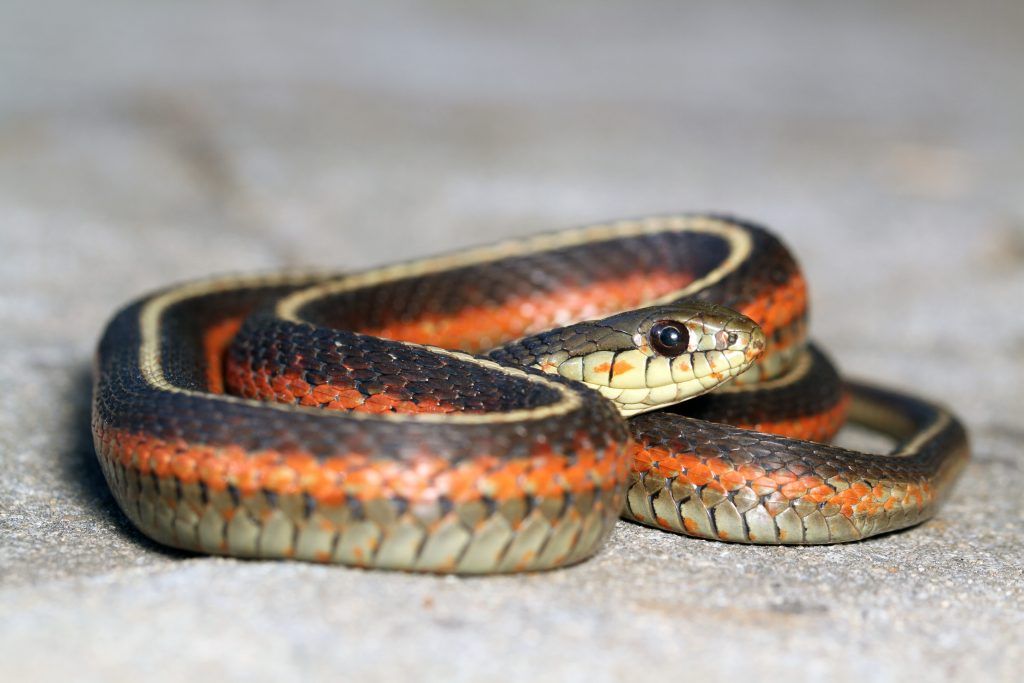
- Species: T. elegans
- Longevity: 10 years
- Adult size: 2–3 feet
The mountain garter snake is a slender snake that can grow up to 3 feet long. It has a black or brown background color with yellow, orange, or red stripes along its body. It lives in moist habitats near streams, ponds, lakes, or marshes, feeding on fish, frogs, salamanders, and worms. It’s active during the day and hibernates in winter.
The mountain garter snake is not aggressive and will rarely bite humans. However, it may release a foul-smelling musk when handled or threatened. It is also protected by law in some states, so it’s not recommended to keep it as a pet.
Marcy’s Checkered Garter Snake
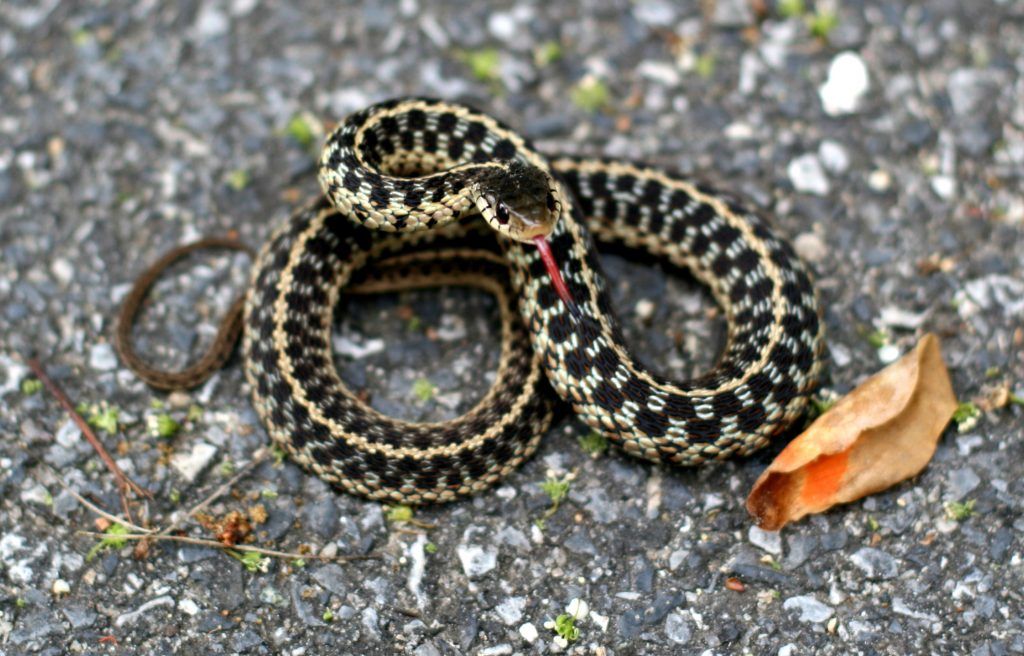
- Species: T. marcianus
- Longevity: 10 years
- Adult size: 2–3 feet
Marcy’s checkered garter snake is a subspecies of the common garter snake endemic to California. It has a dark background color with light checkered markings and three longitudinal stripes that can be yellow, orange, or red. It prefers grasslands, chaparral, woodlands, and riparian areas, where it hunts for fish, frogs, lizards, and mice. It is diurnal and semi-aquatic.
Marcy’s checkered garter snake is not aggressive and will rarely bite humans. However, it may release a foul-smelling musk when handled or threatened. It is also protected by law in some states, so it is not recommended to keep it as a pet.
Gopher Snake

- Species: P. catenifer
- Longevity: 15 years
- Adult size: 4–7 feet
The gopher snake is one of the largest snakes in California, reaching up to 7 feet long. It has a tan or brown background color with dark blotches on its back and sides. It inhabits various habitats, from deserts to forests, preying on rodents, rabbits, birds, and eggs. It is mostly active during the day but may hunt at night in hot weather.
The gopher snake is not venomous but may mimic a rattlesnake when threatened by hissing and coiling its body. It may also strike with its mouth closed or bite if provoked. It is generally docile and easy to handle if captive-bred and well-socialized.
Rosy Boa
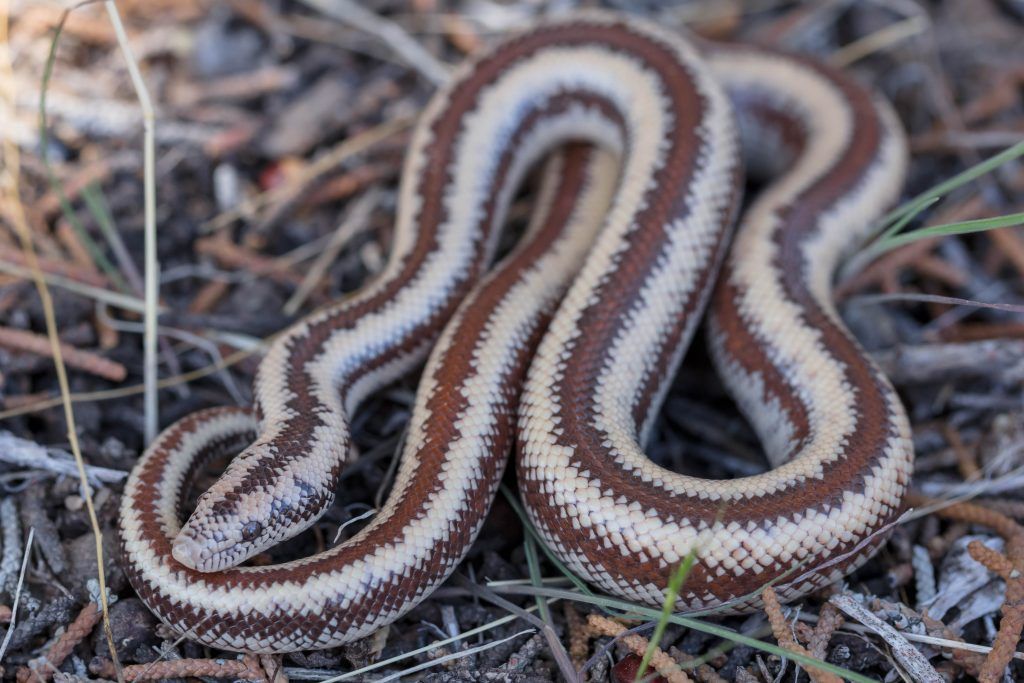
- Species: L. trivirgata
- Longevity: 25 years
- Adult size: 2–3 feet
The rosy boa is a small snake growing up to 3 feet long. It has a pinkish or orange background color with dark brown or black bands along its body. It lives in rocky areas with crevices or burrows, where it feeds on small mammals, birds, and lizards. It is nocturnal and secretive and rarely seen by humans. It is one of the few snakes that give birth to live young.
The rosy boa is not aggressive and will rarely bite humans. It is gentle and calm and makes a good pet for beginners. It requires minimal care and can live for a long time in captivity.
Coachwhip Snake

- Species: M. flagellum
- Longevity: 16 years
- Adult size: 6–8 feet
The coachwhip snake is a fast-moving snake that can reach up to 8 feet long. It has a variable coloration that can be black, brown, tan, pink, or red, depending on the region. It inhabits open areas with sparse vegetation, where it hunts for lizards, snakes, rodents, birds, and insects. It is diurnal and terrestrial but can also climb trees and swim.
The coachwhip snake is not venomous but may be aggressive and bite humans if cornered or handled. It is also very active and nervous and does not tolerate captivity well. It is not recommended to keep it as a pet.
California Kingsnake
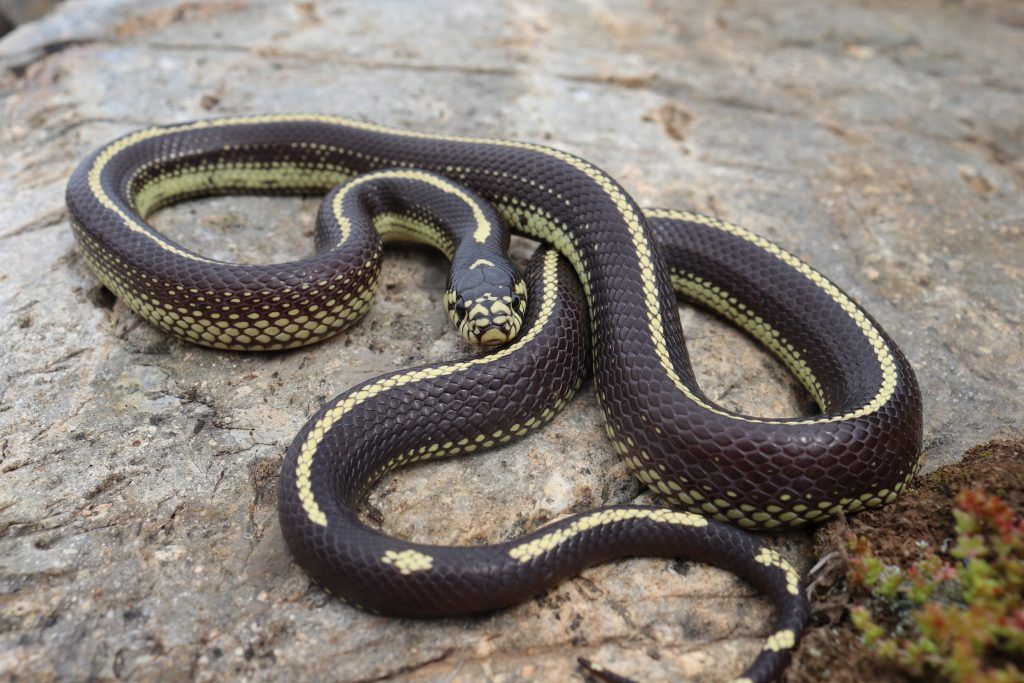
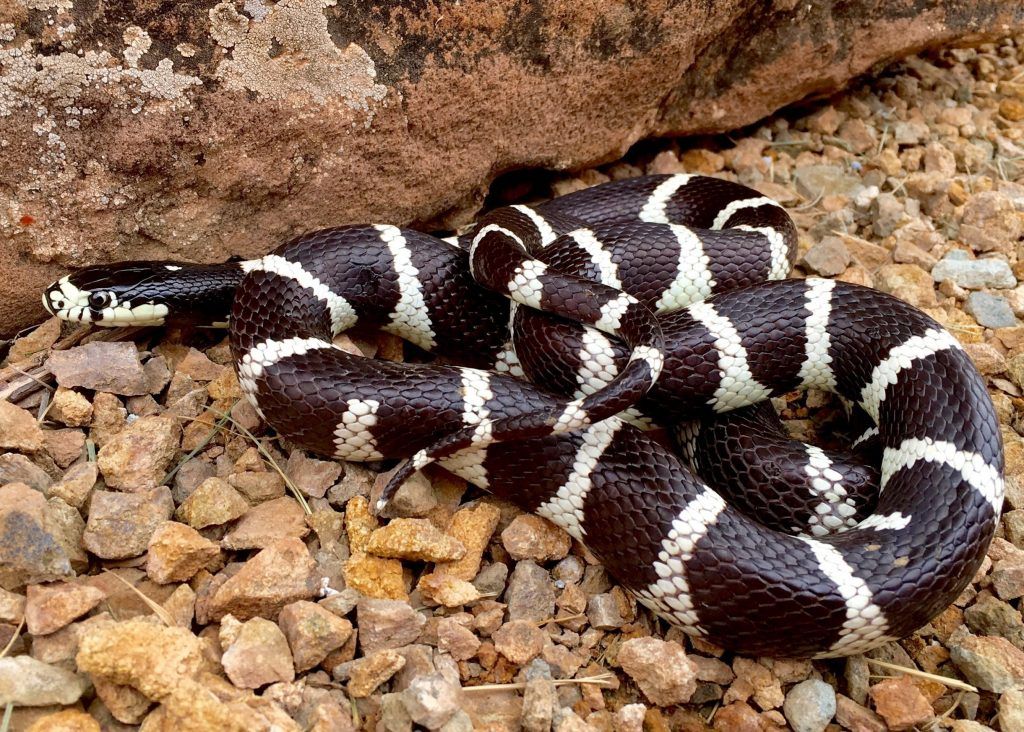
- Species: L. californiae
- Longevity: 20 years
- Adult size: 3–4 feet
The California kingsnake is a medium-sized snake growing up to 4 feet long. It has a black or brown background color with white or yellow bands or stripes along its body. It occupies many habitats, from coastal areas to mountains, where it feeds on rodents, birds, lizards, and other snakes, including venomous ones. It is immune to rattlesnake venom and can constrict its prey to death.
The California kingsnake is not aggressive and will rarely bite humans. It is docile and easy to handle if captive-bred and well-socialized. It is one of the most popular pet snakes in the world due to its attractive appearance and low maintenance.
Variable Ground Snake
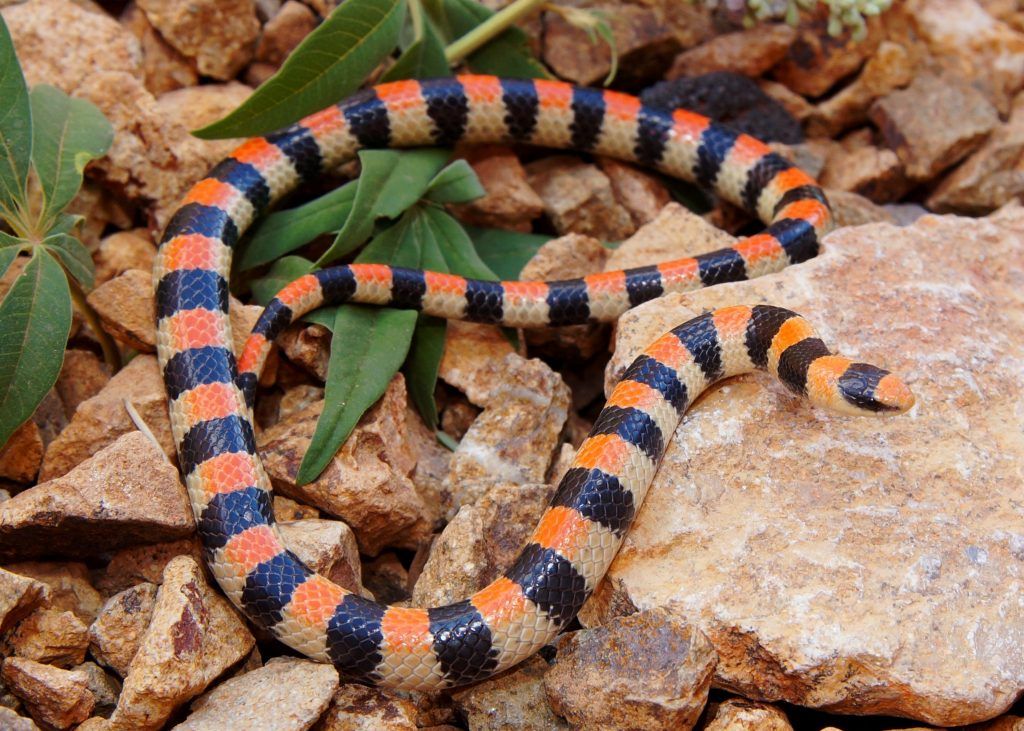
- Species: Sonora semiannulata
- Longevity: 10 years
- Adult size: 1–2 feet
The variable ground snake is a small snake that can reach up to 2 feet long. It has a gray or brown background color with dark spots or blotches on its back and sides. It lives in sandy or gravelly soils with sparse vegetation, feeding on insects, spiders, scorpions, centipedes, and snails. It is nocturnal and fossorial (burrowing) and rarely seen above ground.
The variable ground snake is not aggressive and will rarely bite humans. However, it may release a foul-smelling musk when handled or threatened. It is also secretive and shy and does not do well in captivity.
Coast Mountain Kingsnake
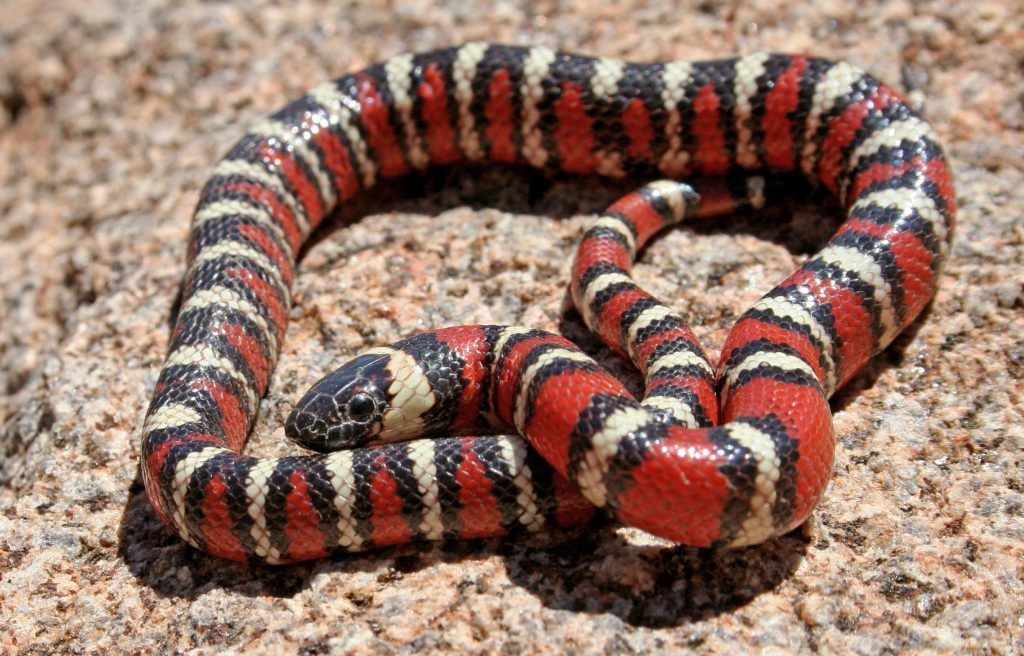
- Species: L. zonata multifasciata
- Longevity: 15 years
- Adult size: 2–3 feet
The coast mountain kingsnake is a subspecies of the California mountain kingsnake found only in California. It has a black background color with red or orange bands bordered by white or yellow bands. It inhabits moist forests and woodlands at high elevations (above 3000 feet), where it preys on lizards, snakes (including rattlesnakes), salamanders, and slugs.
The coast mountain kingsnake is not aggressive and will rarely bite humans. However, it may release a foul-smelling musk when handled or threatened. It is also rare and protected by law in some states, so it is not recommended to keep it as a pet.
4 Venomous Snakes From California
Venomous snakes are dangerous to humans and can cause serious injury or death if bitten. They have specialized teeth called fangs that inject venom into their prey or enemies. They can be identified by their triangular-shaped heads, elliptical pupils, and heat-sensing pits on their faces. Here are four venomous snakes from California that you should avoid:
Southern Pacific Rattlesnake
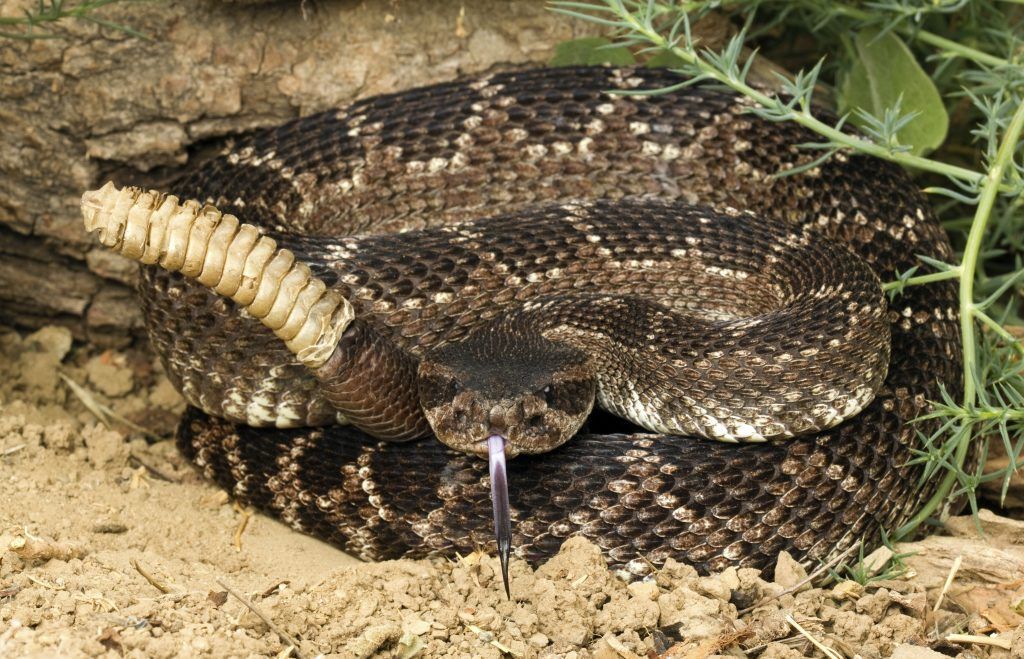
- Species: C. oreganus helleri
- Longevity: 20 years
- Adult size: 4–6 feet
The southern Pacific rattlesnake is a subspecies of the western rattlesnake common in southern California. It has a brown or gray background color with dark diamond-shaped markings on its back and a black-and-white banded tail that ends with a rattle. It inhabits various habitats, from deserts to forests, where it feeds on rodents, rabbits, birds, and lizards. It is active during the day or night, depending on the season and temperature.
The southern Pacific rattlesnake is the most venomous rattlesnake in California and can deliver a painful and potentially fatal bite. Its venom contains hemotoxins that destroy blood cells and tissue and neurotoxins that affect the nervous system. It can also cause severe swelling, bleeding, pain, nausea, vomiting, and shock.
The southern Pacific rattlesnake is very defensive and will rattle its tail to warn intruders. If the warning is ignored, it will strike with lightning speed and accuracy. It can also coil its body and launch itself forward to reach its target.
The southern Pacific rattlesnake is illegal to own as a pet in California, as it poses a serious risk to public safety and health. It is also protected by law in some areas, as it plays an important role in the ecosystem by controlling rodent populations.
If you encounter a southern Pacific rattlesnake, you should keep a safe distance and avoid provoking it. If you are bitten by one, you should seek medical attention immediately and call 911. You should also try to remain calm and limit your movement to slow down the spread of venom. You should not apply a tourniquet, cut the wound, or suck out the venom, as these methods are ineffective and may cause more harm.
Western Diamondback Rattlesnake
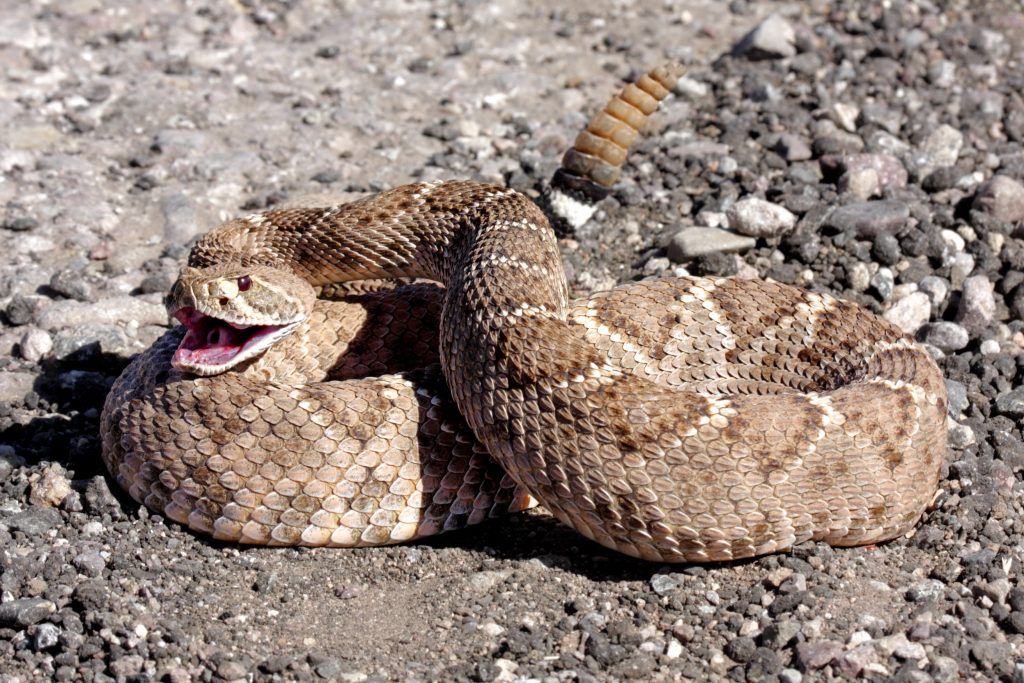
- Species: C. atrox
- Longevity: 20 years
- Adult size: 5–6 feet
The western diamondback rattlesnake is the largest rattlesnake in California, reaching up to 6 feet long. It has a tan or gray background color with dark diamond-shaped markings on its back and a black-and-white banded tail that ends with a rattle. It inhabits arid and semi-arid regions with rocky or sandy soils, feeding on rodents, rabbits, birds, and lizards. It is active during the day or night, depending on the season and temperature.
The western diamondback rattlesnake is highly venomous and can deliver a powerful bite. Its venom contains hemotoxins that destroy blood cells and tissue and neurotoxins that affect the nervous system. It can also cause severe swelling, bleeding, pain, nausea, vomiting, and shock.
The western diamondback rattlesnake is highly aggressive and can strike from a long distance. It will rattle its tail loudly to warn intruders and may also coil its body and launch itself forward to reach its target.
The western diamondback rattlesnake is illegal to own as a pet in California, posing a serious risk to public safety and health. It is also protected by law in some areas, as it plays an important role in the ecosystem by controlling rodent populations.
If you encounter a western diamondback rattlesnake, you should keep a safe distance and avoid provoking it. If you are bitten by one, you should seek medical attention immediately and call 911. You should also try to remain calm and limit your movement to slow down the spread of venom. You should not apply a tourniquet, cut the wound, or suck out the venom, as these methods are ineffective and may cause more harm.
Red Diamond Rattlesnake
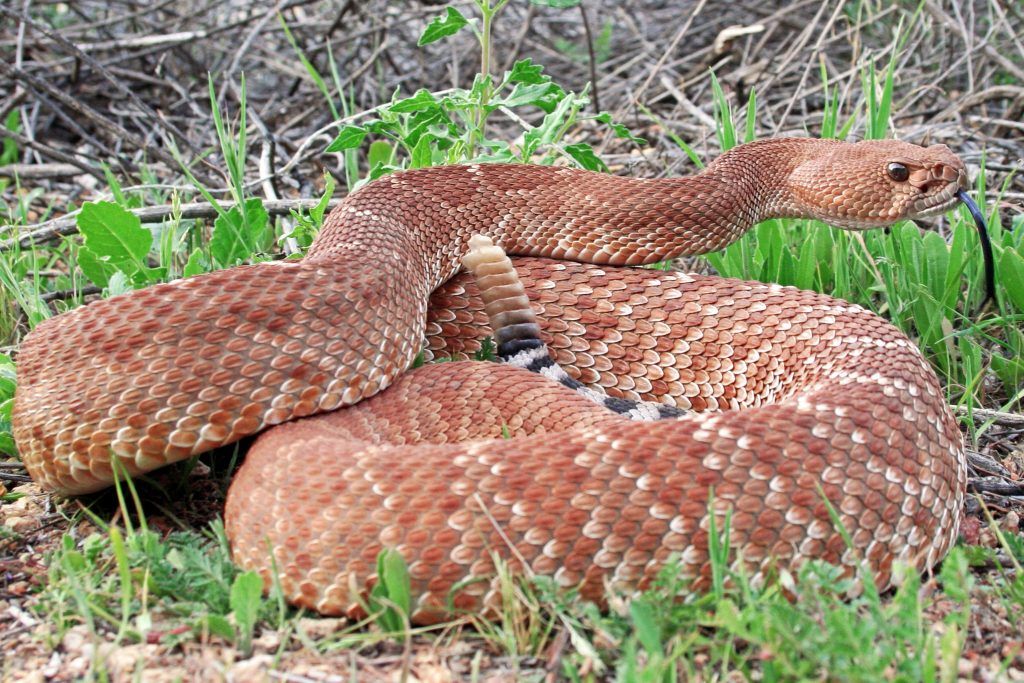
- Species: C. ruber
- Longevity: 20 years
- Adult size: 4–5 feet
The red diamond rattlesnake is a subspecies of the western diamondback rattlesnake found only in California. It has a reddish-brown background color with dark diamond-shaped markings on its back and a black-and-white banded tail that ends with a rattle. It inhabits coastal areas, valleys, and mountains, feeding on rodents, rabbits, birds, and lizards. It is active during the day or night, depending on the season and temperature.
The red diamond rattlesnake is venomous and can deliver a painful bite. Its venom contains hemotoxins that destroy blood cells and tissue and neurotoxins that affect the nervous system. It can also cause severe swelling, bleeding, pain, nausea, vomiting, and shock.
The red diamond rattlesnake is less aggressive than other rattlesnakes but still very dangerous. It will rattle its tail to warn intruders but may strike without warning if provoked. It can also coil its body and launch itself forward to reach its target.
The red diamond rattlesnake is illegal to own as a pet in California, as it poses a serious risk to public safety and health. It is also protected by law in some areas, as it plays an important role in the ecosystem by controlling rodent populations.
If you encounter a red diamond rattlesnake, you should keep a safe distance and avoid provoking it. If you are bitten by one, you should seek medical attention immediately and call 911. You should also try to remain calm and limit your movement to slow down the spread of venom. You should not apply a tourniquet, cut the wound, or suck out the venom, as these methods are ineffective and may cause more harm.
Southwestern Speckled Rattlesnake
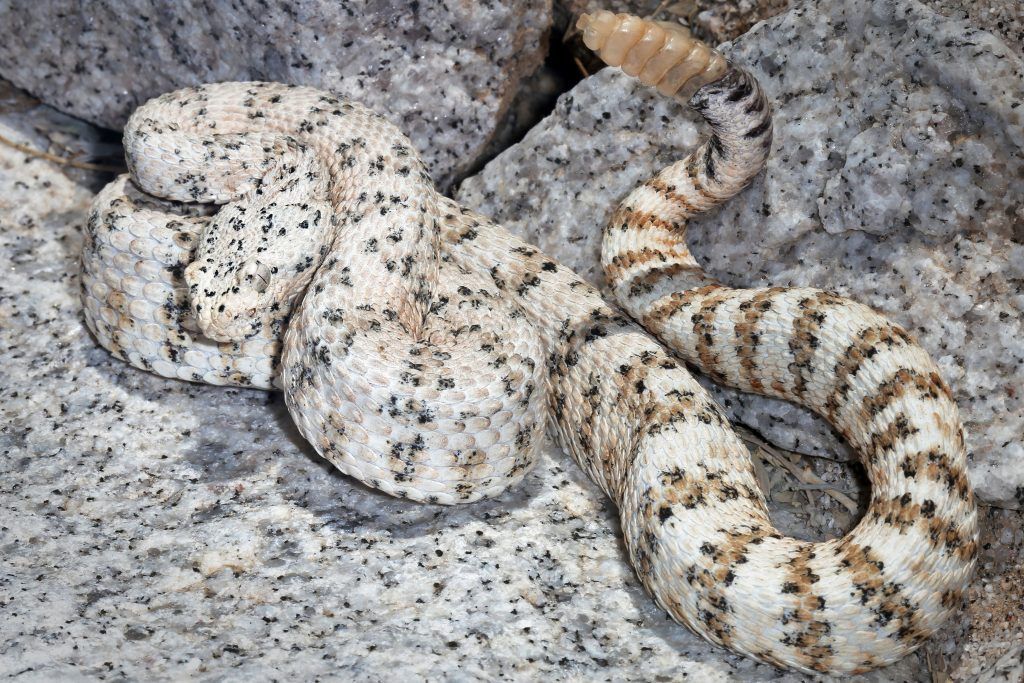
- Species: C. mitchellii pyrrhus
- Longevity: 15 years
- Adult size: 3–4 feet
The southwestern speckled rattlesnake is a subspecies of the speckled rattlesnake found only in California. It has a pinkish or yellowish background color with dark speckles or blotches on its back and a black-and-white banded tail that ends with a rattle. It inhabits rocky areas with crevices or ledges, feeding on rodents, lizards, and birds. It is active during the day or night, depending on the season and temperature.
The southwestern speckled rattlesnake is highly venomous and can deliver a dangerous bite. Its venom contains hemotoxins that destroy blood cells and tissue and neurotoxins that affect the nervous system. It can also cause severe swelling, bleeding, pain, nausea, vomiting, and shock.
The southwestern speckled rattlesnake is rarely encountered by humans, as it is very secretive and camouflaged. It will rattle its tail to warn intruders but may strike without warning if disturbed. It can also coil its body and launch forward to reach its target.
The southwestern speckled rattlesnake is illegal to own as a pet in California, posing a serious risk to public safety and health. It is also protected by law in some areas, as it plays an important role in the ecosystem by controlling rodent populations.
If you encounter a southwestern speckled rattlesnake, you should keep a safe distance and avoid provoking it. If you are bitten by one, you should seek medical attention immediately and call 911. You should also try to remain calm and limit your movement to slow down the spread of venom. You should not apply a tourniquet, cut the wound, or suck out the venom, as these methods are ineffective and may cause more harm.
Conclusion
California is home to 12 snakes that you might encounter in your travels or backyard. Some of them are harmless and beneficial to the ecosystem, while some are venomous and pose a threat to humans and pets. In this article, we have introduced you to these snakes and told you how to identify them, where they live, what they eat, and what to do if you encounter them.
Remember to respect these animals and their habitats, and never try to handle or harm them. If you are bitten by a venomous snake, seek medical attention immediately.
























